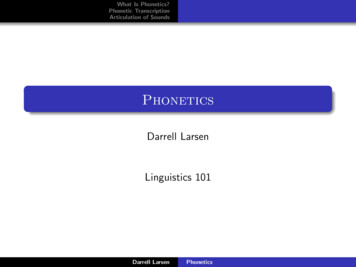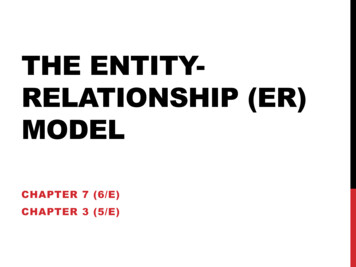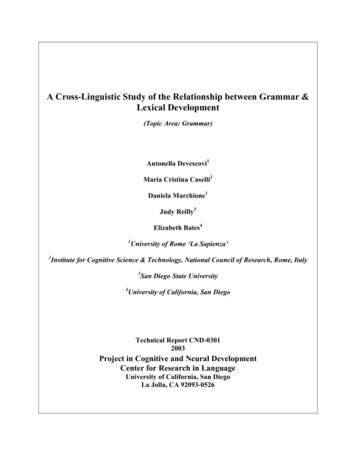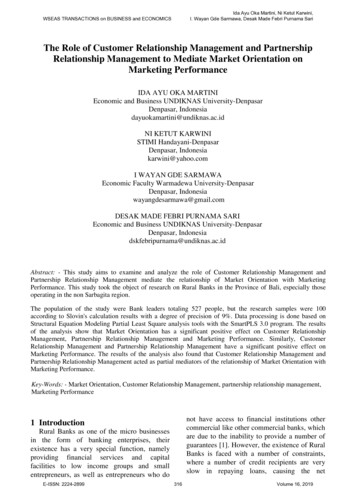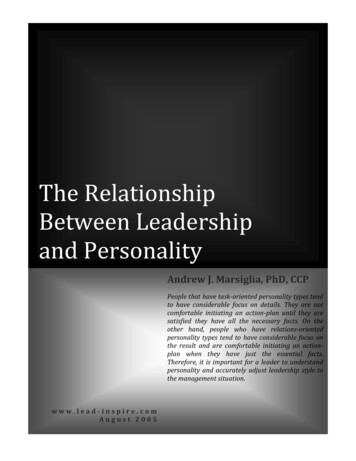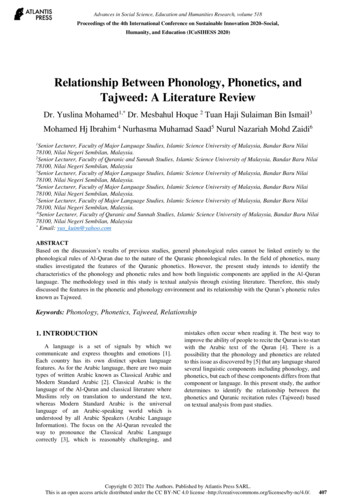
Transcription
Advances in Social Science, Education and Humanities Research, volume 518Proceedings of the 4th International Conference on Sustainable Innovation 2020–Social,Humanity, and Education (ICoSIHESS 2020)Relationship Between Phonology, Phonetics, andTajweed: A Literature ReviewDr. Yuslina Mohamed1,* Dr. Mesbahul Hoque 2 Tuan Haji Sulaiman Bin Ismail3Mohamed Hj Ibrahim 4 Nurhasma Muhamad Saad5 Nurul Nazariah Mohd Zaidi61Senior Lecturer, Faculty of Major Language Studies, Islamic Science University of Malaysia, Bandar Baru Nilai78100, Nilai Negeri Sembilan, Malaysia.2Senior Lecturer, Faculty of Quranic and Sunnah Studies, Islamic Science University of Malaysia, Bandar Baru Nilai78100, Nilai Negeri Sembilan, Malaysia3Senior Lecturer, Faculty of Major Language Studies, Islamic Science University of Malaysia, Bandar Baru Nilai78100, Nilai Negeri Sembilan, Malaysia.4Senior Lecturer, Faculty of Major Language Studies, Islamic Science University of Malaysia, Bandar Baru Nilai78100, Nilai Negeri Sembilan, Malaysia.5Senior Lecturer, Faculty of Major Language Studies, Islamic Science University of Malaysia, Bandar Baru Nilai78100, Nilai Negeri Sembilan, Malaysia.,6Senior Lecturer, Faculty of Quranic and Sunnah Studies, Islamic Science University of Malaysia, Bandar Baru Nilai78100, Nilai Negeri Sembilan, Malaysia*Email: yus kuim@yahoo.comABSTRACTBased on the discussion’s results of previous studies, general phonological rules cannot be linked entirely to thephonological rules of Al-Quran due to the nature of the Quranic phonological rules. In the field of phonetics, manystudies investigated the features of the Quranic phonetics. However, the present study intends to identify thecharacteristics of the phonology and phonetic rules and how both linguistic components are applied in the Al-Quranlanguage. The methodology used in this study is textual analysis through existing literature. Therefore, this studydiscussed the features in the phonetic and phonology environment and its relationship with the Quran’s phonetic rulesknown as Tajweed.Keywords: Phonology, Phonetics, Tajweed, Relationship1. INTRODUCTIONA language is a set of signals by which wecommunicate and express thoughts and emotions [1].Each country has its own distinct spoken languagefeatures. As for the Arabic language, there are two maintypes of written Arabic known as Classical Arabic andModern Standard Arabic [2]. Classical Arabic is thelanguage of the Al-Quran and classical literature whereMuslims rely on translation to understand the text,whereas Modern Standard Arabic is the universallanguage of an Arabic-speaking world which isunderstood by all Arabic Speakers (Arabic LanguageInformation). The focus on the Al-Quran revealed theway to pronounce the Classical Arabic Languagecorrectly [3], which is reasonably challenging, andmistakes often occur when reading it. The best way toimprove the ability of people to recite the Quran is to startwith the Arabic text of the Quran [4]. There is apossibility that the phonology and phonetics are relatedto this issue as discovered by [5] that any language sharedseveral linguistic components including phonology, andphonetics, but each of these components differs from thatcomponent or language. In this present study, the authordetermines to identify the relationship between thephonetics and Quranic recitation rules (Tajweed) basedon textual analysis from past studies.Copyright 2021 The Authors. Published by Atlantis Press SARL.This is an open access article distributed under the CC BY-NC 4.0 license 7
Advances in Social Science, Education and Humanities Research, volume 5181.1. The Terminology of Phonology andPhonetics)Phonology familiarly gets us figured out what eachsound does and acts such as when it combines with othersounds. In general, [6] stated that phonology is one of thelinguistic branches by which permits us to feel connectedwith a language to reach its very root known as languagesound. The produced sound of languages can carry anymeaning in the style sounds presented. In the aspect oflinguistics, the research by [7] mentioned that thelanguage shared some linguistic components namelysemantics, syntax, morphology, phonology, andphonetics. What is phonetics? The study of phonetics iswidely found in many disciplines of linguistic studies asphonetics is much closer related to any sound producedfrom text-to-speech or speech-to-text. According to [8],phonetics and phonology can be defined as:i.Cannorn and Ekundare defined phonetics as thesound of the basis of human speech as an acousticphenomenon that has a source of vibration somewhere inthe vocal apparatus.ii. Varshney defined phonetics as a scientific studyof the production, transmission, and reception of speechsounds.iii. Ramamurthi defined phonology when itinvolves the evaluation, analysis, arrangement, anddescription of the phonemes or meaningful sounds of alanguage.iv. Simpson defined phonology as the statement ordescription of the lingual stoically relevantsuprasegmental features, the phonetic system,allophones, their distribution, and the phonologicalstructure.v. Ekundare defined phonology simply as a studyof the properties of the sound system of a language whichspeakers have mastered or internalized by the time theyare competent users of it.Furthermore, [9] defined phonetics as a general studyof human sounds without referring to their systemic rolesin a specific language, while phonology is a system ofsounds by means of which the meanings aredifferentiated in a language that served as the buildingblocks or the higher linguistic levels such as morphology.Based on those definitions, the term phonetics can beunderstood as the study of the production of sound fromthe basic of human speech while phonology is the studyof the sound’s properties and features. Each speech orutterance has its own phonetic features and properties,which give different meanings to the expression uttered,more accurately referred to as language prosody. A studyby [10] discovered that language differs in a phoneticproperty which is categorized into two situations whetherit is used to convey post-lexical meaning or have becomeconventionalized bearers of post-lexical meaning, thus apart of the phonological language. In general, thephonetic and phonological properties of language areused to convey the post-lexical of meaning languageprosody.1.2. Quranic Recitation Rules (Tajweed)In general, the phonemes of any language can beclassified into two categories: vowels that contain nomajor air restriction through the vocal tract, andconsonants that involve a significant restriction andtherefore weaker in amplitude, and often "noisier," thanvowels [22]. Based on the Quranic text analyzed andtranscribed in relation to the distinct syllable conductedby [23], the complete set of Quran consists of 211, 573syllables where 2, 642 syllables of that total are distinct.On the other hand, [24] addressed that the knowledgeof Tajweed is contingent on four matters which areKnowledge of the articulation points of the letters,Knowledge of the characteristics of the letters,Knowledge of the rules of change in letters due to theorder of the letters, and exercising the tongue and a lot ofrepetition. The way to pronounce the letter of the Quranis related to the term called phonetics, where eachsyllable, phonemes of Arabic letter required a specificsound to be pronounced based on the Quranic recitationrules for instance Idgham, Izhar, Ikhfaa, and Qalqalah,which involve the nasal assimilation particularly inlearning Tajweed [25].In regard to one of the general characteristics inArabic linguistic, the Arabic language has short vowelswhich are usually ignored in the text but make adifference in meaning when reading an Arabic text [26].In the discussion of their study, there is a differencebetween writing and reading the Quran, which is a specialcase that the Quranic recitation rules must be followedwhen reciting the Quran. This finding is supported by[27] who conducted a study to acquire a complete set ofdistinct syllables from a set of Quran verses (Ayat) thatemphasized the Quranic texts are fully vocalized, whichmeans a proper diacritic are placed on each letter of thetexts. Therefore, it is the basis for the correct recitation ofthe Quran when the accuracy of Quranic text is verycritical. Thus, the rules of Tajweed can be classified intofour which are Nun Sakinah and Tanween Rules, Nunand Mim Mushaddad, Mim Sakinah Rules and AlQalqalahi.Nun and Mim Mushaddad mean that nun ormim has shaddah with Ghunnah of two beats.ii. Al-Qalqalah is the vibration of sound at the endof the pronunciation of certain letters; Qaaf, Ttaa, Baa,Jiim and Daal, when the letter carries sukoon or shaddah.iii. Nun Sakinah and Tanween Rules; Nun Sakinahmeans no Harakah or Sukun sign on Nun, Tanween is a408
Advances in Social Science, Education and Humanities Research, volume 518nun sakinah at the end of nouns that pronounced as NunSakinah but without written the Nun.iv. Mim Sakinah Rules is no Harakah or with aSukun sign on Mim.v. Al-Madd Rules means the letter of Madd ispronunced long under some conditions, from two to sixbeats depending upon its type [28]. Then, each of NunSakinah or Tanween Rules, Mim Sakinah and Al-Madd,have more sub-classes of Rules:Table 1. Research on the Phonological and PhoneticRules in Quranic Recitation Rules (Tajweed)Research(Year)i.Nun Sakinah or Tanween Rules is classified intofour sub-classes: Izhar Halqi, Iqlab, Idgham, and IkhfaaHalqiii. Mim Sakinah with three types of Rules: IkhfaaShafawi, Idgham Shafawi, and Izhaar Shafawi.(Amer,2016)ResearchDiscussionCompare thephonetic rulesof the AlQuran to thephonetic rulesof the Englishlanguage.DemonstratePhoneticsthe existingfeatures in thephonetic ofArabic andEnglish speechsound anddifferentiateQuranicphonetic rulesfrom otherArabicliterature.iii. Al-Madd has eight Rules: Tabii’ie, Al-Badal,‘Ewadh, Mad ‘Aridh Li-Sukun, Al-Leen, Muttasil,Mumfasil, and Laazim.Based on the Rules, [29] mentioned in his study that thecharacteristics or Sifaat of the Arabic letters are dividedinto two groups, namely characteristics with opposites,and characteristics without opposites. He also addressedthat Qalqalah is one of the most well-known rules but hassome very difficult characteristics to pronounce:bouncing or echoing of sound.1.3. Phonetics, Phonology and QuranicRecitation Rules (Tajweed)In a modern way, the Quranic recitation technique ispresented in technological mediums such as applications,and speaker recognition system to assist non-Arabic ornew learner recites correctly as the recitation rules arecomplex and critical. These tools assist in the aspect ofArabic language learning, especially in pronunciation.[30] mentioned in their study that the aspect related topronunciation learning is referred to as another termknown as Computer-Aided Pronunciation Learning(CAPL). It revealed the achievements in the fields ofcomputer-aided learning systems, intelligent tutoringsystems, speech recognition, speech synthesis, anddialogue systems, which permits the ability to produceefficient computer-aided systems in language learningfields.Concerned about on how the sound and pronunciationof Arabic syllables are generated, many studies andmodels were built to investigate the Tajweed Rules andits correct pronunciation, thus helped novice learners andtheir interest to learn Quranic characters. The literaturereview of the phonology and phonetics rules in Quranicrecitation rules found that both phonology and phoneticsare applied to investigate the pronunciation’s techniqueof Tajweed Rules analysed from the verses of Al-Quranas in Table 1.Apply therules of thegenerativephonological(Altheory to theShishtawi,rules of the2018)phonologicalsystem of theQur'anicphonology.Investigatethe actualpronunciation(Shariq,of Arabic and2015)Englishconsonants(Aldubai,2015)Linguistic Quran’senvironme phonetic RulesntResearchObjectiveDiscuss thephonologicalpatterns inQuranicverse-finali.pauses(fawasil)ii.Discusses theprocess ofnasal(Kasnin &assimilationJaafar,which existed2018)in the selectedrule ofTajweedArgue thephonological(Aland phoneticSolami,sound alrules for theQur'anicphonologicalrules.Analysis ofphonetics andphonologicaltools for thepronunciationof consonantsof Arabic andEnglishInvestigationfocus on threemajor phoneticcriteria:The phoneticfeatures of thefawasilThe Fasilahshift from thesurroundingfawasil.Thesemanticallyoriented soundsAnalysis of thephonologicalprocess andpronunciationof Idgham h),Rules of (Al-Ikhfaa’),elongation (Madal-tamkeen),Slanting orInclination(Imala).Phonology Noon Sakinahand TanweenPhonetics It does notandspecialize inPhonology Tajweed rules.PhoneticsFocus on thesymmetrical andtheasymmetricalpauses (fawasil)in terms ofconcordance(al-nasaq alsawti)Phonology Focus onIdhgam Bila alGhunnahArgue bothPhonology It does notphonology and andspecialize inphonetics is not phonetics Tajweed Rules.part of theFocus on ArabicArabic gutturalemphatics.class.409
Advances in Social Science, Education and Humanities Research, volume 518Phonetically, Amer and Aldubai discovered thedifferent areas of phonetic features where Amercompared Al-Quran’s phonetic rules with anotherlanguage while Aldubai focused his study on thephonetics of Al-Quran verses-final pause (fawasil).Phonologically, Al-Shishtawi and Kasnin & Jaafargenerate the phonological rules applied on Quranicphonological rules where Al-Shishtawi discovered thatthe phonological rules are applied partially in some casesdue to the nature of the Quranic phonological rules, whileKasnin & Jaafar only focused their study on thephonology rules at a case of the nasal assimilationprocess. Lastly, Shariq and al-Solami covered both areasof the linguistic components phonology and phonetics.Al-Solami claimed that both phonetics and phonology arenot part of Arabic guttural class, while Shariq found thateven phonetics and phonology are different in linguisticpattern, he claimed that the elaboration of the similaritiesand dissimilarities between the Arabic and Englishconsonantal sound solved the problem of pronunciation.2.CONCLUSIONAs a conclusion from the discussion, the phonetic canbe applied in the Quranic phonetic rules as stated byAmer (2016) that the Quran’s phonetic rules are notconnected to the Arab tongue, but rather, it is by whichthe human tongue was created to function. Therefore, asimilar comparison is welcomed to be studied with otherlanguages to verify the nature of the phonetics of theQuran. On the phonological side, the phonological rulescan be applied in Quranic phonological rules partially atsome cases due to the complex nature of Quranicphonological rules and sound structures.AUTHORS’ CONTRIBUTIONSDesign of the Work (Mesbahul Hoque)Data Collection (Mohamed Hj Ibrahim)Data Analysis (Nurhasma Muhamad Saad)Drafting the Article (Tuan Hj Sulaiman Ismail)Paper Write-Up (Nurul Nazariah Mohd Zaidi)Final Approval (Dr. Yuslina ntUSIM/FRGS/FPBU/055002/50518, project entitled:Interaksi Organ Pertuturan, Bunyi dan PerkembanganBahasa Kanak-kanak dalam Membentuk Modal BacaanAl-Quran untuk Golongan Tidak Minat al-Quran.REFERENCES[1] Al-Shishtawi, H. I. (2018). The Behavior of NoonSaakinah and Tanween in Quranic Recitation: In theLight of Generative Phonology. InternationalJournal of Language and Linguistics, 5(4), 81-89.[2] Ahmed, A. H., & Abdo, S. M. (2017). VerificationSystem for Quran Recitation Recordings.International Journal of Computer Application,163(4), 6-11.[3] Mostafa Belkasmi, M. O., Elhadj, Y. O., &Abdellah, Y. (2017). Strategies for Implementing anOptimal ASR System for Quranic RecitationRecognition. International Journal of ComputerApplications, 172(9), 35-41.[4] Zeroual, I., & Lakhouaja, A. (2016). A New QuranicCorpus Rich in Morphosyntactical Information.International Journal of Speech Technology, 19(2),339-346.[5] Al-Shishtawi, H. I. (2018). The Behavior of NoonSaakinah and Tanween in Quranic Recitation: In theLight of Generative Phonology. InternationalJournal of Language and Linguistics, 5(4), 81-89.[6] Perea, D., Roo, S., & Loera, E. (2013). EffectivePhonological Tools to Enhance Listening Skills inthe Classroom. Conference Proceeding 2013, 1-8.[7] Al-Shishtawi, H. I. (2018). The Behavior of NoonSaakinah and Tanween in Quranic Recitation: In theLight of Generative Phonology. InternationalJournal of Language and Linguistics, 5(4), 81-89.[8] Shariq, M. (2015). Arabic and English Consonants:A Phonetic and Phonological Investigation.Advances in Language annd literary Studies, 6(6),146-152.[9] Hickey, R. (2019). Essentials of Phonetics andPhonology. Retrieved August 01, 2019, fromCoursehero: uni-due.de/ELE/Essentials.pdf[10] Stevens, J., Marneffe, M.-C., Speer, S., &Tonhauser, J. (2017). Predicting projection fromrational use of prosody. Annual Conference of theCognitive Science Society, 1144-1149.[11] Mostafa Belkasmi, M. O., Elhadj, Y. O., &Abdellah, Y. (2017). Strategies for Implementing anOptimal ASR System for Quranic RecitationRecognition. International Journal of ComputerApplications, 172(9), 35-41.[12] Mostafa Belkasmi, M. O., Elhadj, Y. O., &Abdellah, Y. (2017). Strategies for Implementing anOptimal ASR System for Quranic RecitationRecognition. International Journal of ComputerApplications, 172(9), 35-41.[13] Moeen, M., & Hamdani, K. (2017). Influence of AHoly Quran on Arabic Language. Socio-ReligioPolitical Thought of Ghulam Ahmad, 3(2), 1-12.410
Advances in Social Science, Education and Humanities Research, volume 518[14] Brierley, C., Sawalha, M., Heselwood, B., & Atwell,E. (2016). A Verified Arabic-IPA Mapping forArabic Transcription Technology, Informed buQuranic Recitation, Traditional Arabic Linguistics,and Modern Phonetics. Journal of Semitic StudiesSpring 2016, 157-184.[15] Altalmas, T., Jamil, M. A., Ahmad, S., Sediono, W.,E. Salami, M. J., Hassan, S. S., & Embong, A. H.(2017). Lips Tracking Identification of a CorrectQuranic Letters Pronunciation for TajweedTeaching and Learning. Mechatronics andAutomation Enginering, 18(1), 1-8.[16] Aqel, M., & Zaitoun, N. (2015). Tajweed: AnExpert System for Holy Qur'an munication, Management and InformationTechonology (ICCMIT 2015), 65, 807-8012.[17] Altalmas, T., Jamil, M. A., Ahmad, S., Sediono, W.,E. Salami, M. J., Hassan, S. S., & Embong, A. H.(2017). Lips Tracking Identification of a CorrectQuranic Letters Pronunciation for TajweedTeaching and Learning. Mechatronics andAutomation Enginering, 18(1), 1-8.[18] Hashim, A., Jahidih, S., & Che Noh, M. A. (2015).The Relationship between Pedagogical ContentKnowledge and al-Quran Tajweed Performanceamong Students KKQ in Malaysia. 7th WorldConference on Educational Sciences (WCES-2015),197, 1530-1537.[19] Ahmed, A. H., & Abdo, S. M. (2017). VerificationSystem for Quran Recitation Recordings.International Journal of Computer Application,163(4), 6-11.[20] Alduais, A. M. (2015). An Account of Phonetics andPhonology as Similar Identical or Different. TheInternational Journal of Indian Psychology, Communication, Management and InformationTechonology (ICCMIT 2015), 65, 807-8012.[25] Kasnin, N., & Jaafar, S. S. (2018). Assimilasi Nasaldalam Hukum Idgham Bila Al-Ghunnah.Akademika, 88(1), 121-136.[26] Elsayed, E., & Fathy, D. (2018). Evaluation ofQuran Recitation via OWL Ontology Based System.The International Arab Journal of Informationtechnology, 1-8.[27] Al-Muhtaseb, H. A., & Bellegdi, S. A. (2016).Towards A Minimal Phonetic Set for QuranRecitiation. International Journal on Islamic an AlMuhtaseb, H. A., & Bellegdi, S. A. (2016). TowardsA Minimal Phonetic Set for Quran Recitiation.International Journal on Islamic Applications inComputer Science and Technology, 4(2), 36-41.Applications in Computer Science and Technology,4(2), 36-41.[28] Aqel, M., & Zaitoun, N. (2015). Tajweed: AnExpert System for Holy Qur'an munication, Management and InformationTechonology (ICCMIT 2015), 65, 807-8012.[29] Altalmas, T., Ahmad, S., Sedono, W., & Hassan, S.(2015). Quranic Letter Pronunciation Analysisbased on Spectogram Technique: Case Stuyd onQalqalah Letters. AIAI Workshops.[30] Ibrahim, N. J., Idris, M. I., & Yusoff, M. (2014).Computer Aided Pronunciation Learning for AlJabari Method: A Review. International Journal ofQuranic Research (QURANICA), 6(2), 51-68.[31] Yuslina Mohamed, Zainal Abidin. H, (2013).Quranic Miracles in the Book of “Syafiah“ writtenby Abdul Qaher Jurjaani, GJAT DECEMBER2013 VOL 3 ISSUE 2 125. ISSN : 2232-0474 E-ISSN : 2232-0482. www.gjat.my[21] Alduais, A. M. (2015). An Account of Phonetics andPhonology as Similar Identical or Different. TheInternational Journal of Indian Psychology, 3(1),157-168.[22] Aloqayli, F. M., & Alotaibi, Y. A. (2017). SpokenArabic Vowel Recognition Using ANN. EuropeanModelling Symposium (EMS).[23] Al-Muhtaseb, H. A., & Bellegdi, S. A. (2016).Towards A Minimal Phonetic Set for QuranRecitiation. International Journal on IslamicApplications in Computer Science and Technology,4(2), 36-41.[24] Aqel, M., & Zaitoun, N. (2015). Tajweed: AnExpert System for Holy Qur'an Recitation411
of Tajweed Rules analysed from the verses of Al-Quran as in Table 1. Table 1. Research on the Phonological and Phonetic Rules in Quranic Recitation Rules (Tajweed) Research (Year) Research Objective Research Discussion Linguistic environme nt Quran's phonetic Rules (Amer, 2016) Quranic Compare the phonetic rules of the Al-Quran to the

